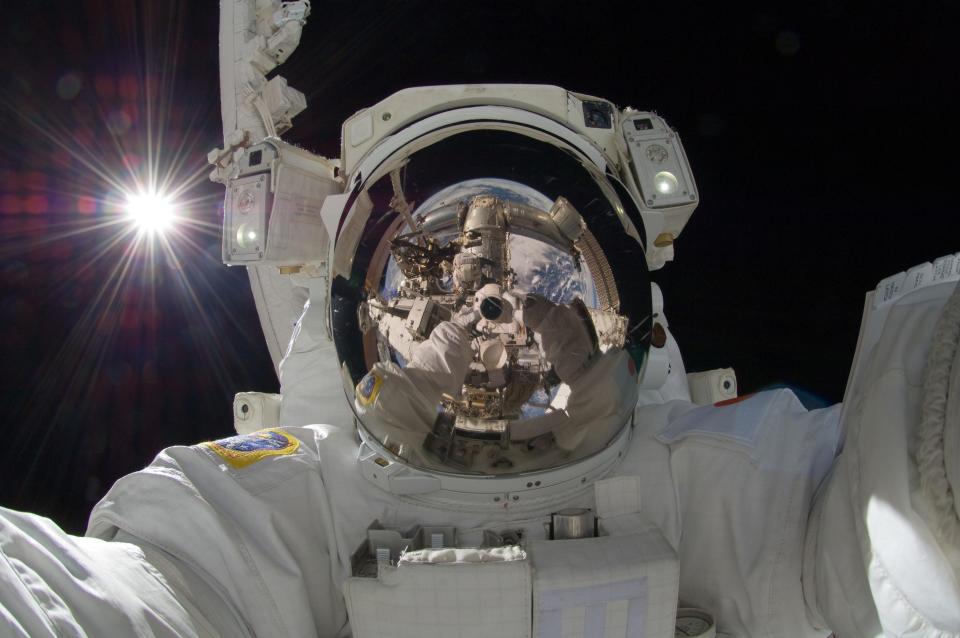Selfie reflections of 2013
When Kim Kardashian decided to debut her newly slim physique in October, four months after giving birth to daughter North West, the reality television queen sidestepped the usual celebrity protocol of posing for the magazine most willing to pay big bucks for the post-baby body reveal.
Instead, Kardashian donned a revealing white swimsuit and posed provocatively in front of a mirror, iPhone in hand, and snapped her own photo.
As if there needed to be more proof, Kardashian’s snapshot confirmed that 2013 was truly the year of the selfie — a slang word for the self-portraiture that has overtaken social media with the rise of cell phone cameras.
[Related: iPhone 5 at No. 9, see what else is on Top Searches of 2013]
Kardashian’s "selfie" which she posted on Instagram and shared on Twitter, quickly went viral. More than 1 million people liked the photo on Instagram — making it one of the photo sharing network’s most popular images of all time — and more than 15,000 Twitter users re-tweeted or favorited the picture. It also landed Kardashian a mention in virtually all the celebrity tabloids, the network morning shows and hundreds of entertainment blogs — priceless publicity for an image that she fully controlled.
It seemed that everybody was snapping selfies this year. When Beyoncé unveiled a dramatic pixie haircut in August, she announced it via a selfie. Chelsea Clinton took a selfie with her mom, former Secretary of State Hillary Clinton. Even Pope Francis was caught posing for a selfie with a flock of his younger faithful at St. Peter’s Basilica over the summer. At the funeral for South African President Nelson Mandela, President Barack Obama was spotted taking a selfie with British Prime Minister David Cameron and Denmark's Prime Minister Helle Thorning.
It’s a form of self-expression that has become so prolific that the word "selfie" was among the few added to the Oxford English Dictionary in August.
[Related: The selfie obsession, and other fixations of 2013]
Except selfies aren’t technically new. People have been taking pictures of themselves almost since the dawn of photography nearly 200 years ago — back when people had to stand still for minutes in order to capture a clear image on long-exposure film.
Since then, some of the most celebrated photographers in the world have made self-portraits a key part of their art. They include Lee Friedlander, who began documenting his image in the 1960s by making pictures of his reflection in storefront windows and as a lurking shadow on the streets of New York City. Decades later, Cindy Sherman took it one step further by donning costumes and disguises in her series of self-portraits as a way to raise questions about how society judges external beauty.
But the rise of smartphones and the popularity of social networks have changed the idea of the self-portrait. (Flickr, a photographers’ haunt now owned by Yahoo, used the shorthand #selfie back in 2004. Now, it can be an instantaneous way for anyone — either the famous and unfamous — to share his or her image with the outside world.
It hasn’t always been graceful: Anthony Weiner’s sexting selfies killed his race for New York City mayor this year and got him kicked out of Congress in 2011. Actress Amanda Bynes’ self-portraits seemed to document a slide into mental illness — and in fact, she was hospitalized over the summer. And Geraldo Rivera lost a few speaking gigs after he posted a nearly nude selfie on Twitter. There was even was a Tumblr launched dedicated solely to embarrassing selfies taken at funerals.
But it’s a trend that’s unlikely to go away anytime soon.
“Young kids, almost babies, are making self-portraits with iPhone cameras before they can even talk,” said Christopher Phillips, a curator at the International Center for Photography in New York. “That’s what’s so extraordinary today and ensures that selfies are going to be something that is with us and talked about for a long time.”



